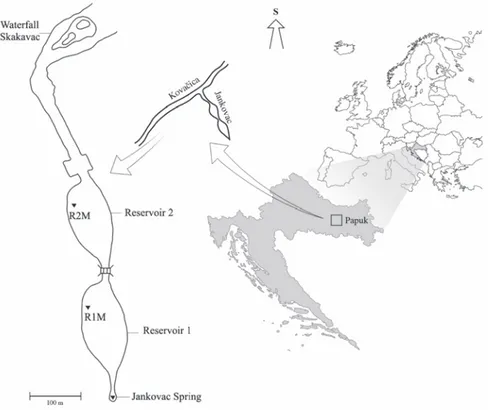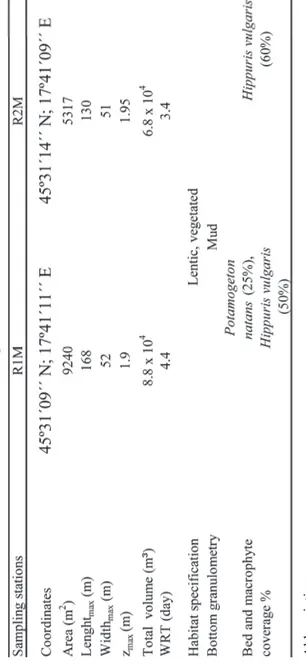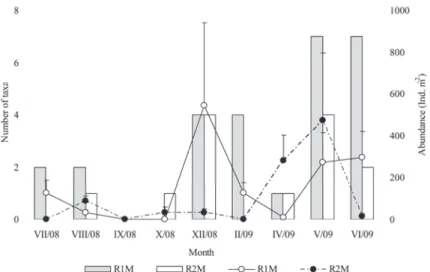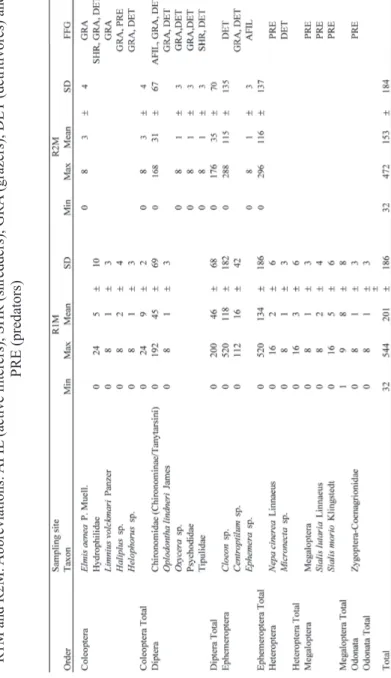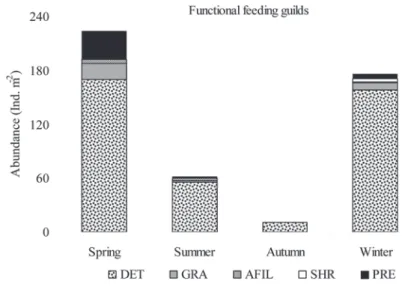Entomol. Croat. 2012, Vol. 16. Num. 1-4: 7-20 ISSN 1330-6200
ENTOMOFAUNA OF SUBMERGED MACROPHYTE STANDS IN
RESERVOIRS (PAPUK NATURE PARK)
Maria ŠPOLJAR, Denis ŠNELLER, Marko MILIŠA, Jasna LAJTNER, Mirela SERTIĆ PERIĆ & Ines RADANOVIĆ
Division of Zoology, Department of Biology, Faculty of Science, University of Zagreb, Rooseveltov trg 6, HR-10 000 Zagreb, Croatia
mspoljar@zg.biol.pmf.hr Accepted: July, 11th 2012
In this study diversity, abundance and functional feeding guild of aquatic entomofauna were assigned within submerged macrophyte stands in Jankovac Stream reservoirs (Papuk Nature Park). The main aims of this study were to analyse: (i) physico-chemical parameters and food resources; (ii) abundance and diversity and (iii) functional feeding guilds of entomofauna. Between reservoirs non signifi cant differences were observed in regard to abiotic or biotic parameters, except higher abundance of active fi lterers in vegetated littoral zone of Reservoir 1 (R1M) than in Reservoir 2 (R2M). Other parameters mostly showed signifi cant seasonal oscillations. In total 19 taxa were identifi ed, among them 14 in R1M, and half less in R2M. Highest abundance was reached in R1M in winter (544 ind m-2), and in R2M in spring (472 ind m-2). Ephemeroptera (R1M 66 %, R2M 76 %) with domination of Cloeon sp., and Diptera (23 % in R1M and R2M) with dominated Tanitarsini specimens contributed at most in total abundance. Among feeding guilds the greatest contribution in abundance achieved detritivores (81 %). Results of this study suggested that food resources and biotic interactions are main drivers in structuring entomofauna, i.e., macroinvertebrate community in submerged macrophyte stands.
Littoral zone, Ephemeroptera, Cloeon, Diptera, functional feeding guilds M. ŠPOLJAR, D. ŠNELLER, M. MILIŠA, J. LAJTNER, M. SERTIĆ PERIĆ i I. RADANOVIĆ: Entomofauna sastojina submerznih makrofi ta u umjetnim ujezerenjima (Park prirode Papuk). Entomol. Croat. 2012. Vol. 16. Num. 1-4: 7-20.
U provedenom istraživanju razmatrana je raznolikost, abundancija i funkcionalne hranidbene skupine akvatičke entomofaune u submerznim sastojinama umjetnih ujezerenja potoka Jankovac (Park prirode Papuk). Glavni
ciljevi ovog istraživanja bili su analizirati: (i) fi zičko-kemijske čimbenike i izvore hrane; (ii) abundanciju i raznolikost te (iii) funkcionalne hranidbene skupine entomofaune. Između ujezerenja nisu utvrđene značajne razlike abiotičkih niti biotičkih čimbenika, izuzev veće abundancije aktivnih fi ltratora u litoralnoj zoni s makrofi tima u ujezerenju 1 (R1M) u odnosu na ujezerenje 2 (R2M). Ostali istraživani čimbenici uglavnom su ukazivali na značajne sezonske razlike. Ukupno je utvrđeno 19 svojti, od kojih je 14 svojti bilo prisutno na postaji R1M, a upola manje na postaji R2M. Najveća abundancija postignuta je zimi na postaji R1M (544 jed. m-2) dok je na postaji R2M maksimum abundancije postignut u proljeće (472 jed. m-2). Ephemeroptera (R1M 66 %, R2M 76 %) s dominantnom svojtom Cloeon sp. i Diptera (23 % u R1M i R2M) s dominacijom jedinki iz skupine Tanitarsini najviše su pridonijeli ukupnoj abundanciji. Između funkcionalnih hranidbenih skupina detritovori su postigli najveći udio (81 %) u ukupnoj abundanciji. Rezultati ovog istraživanja ukazuju da su izvori hrane i interakcije unutar vodenih biocenoza bile glavne odrednice u strukturiranju entomofaune odnosno makrozoobentosa u sastojinama submerznih makrofi ta.
Litoralna zona, Ephemeroptera, Cloeon, Diptera, funkcionalne hranidbene
skupine
Introduction
Aquatic macrophytes play an important role for aquatic biocoenoses (Ku-czyńska-Kippen & Nagengast, 2006; Cañedo-Argüelles & Rieradevall, 2009). They serve as a refuge against predators, mostly fi sh, and provide broad spec-trum of food sources for invertebrates and vertebrates (Rooke, 1984; Scheffer, 2004; Cañedo-Argüelles & Rieradevall, 2009; Špoljar et al., 2011). Macrozoob-enthos, mainly comprised of insect larvae, oligochaetes, gastropods and bivalves, are feeding on detritus, periphyton, plant tissues or are predators that pray on other invertebrates i.e., rotifers, gastropods, crustaceans (Cry & Downing, 1988; Kuczyńska-Kippen, 2003). Also, macrophytes serve as oviposition habitats for fi sh and water birds (Beccera-Munoz & Schramm, 2007; Klaassen & Nolet, 2007). They can reduce fl ow velocity, nutrient concentrations, sediment erosion and resuspension. Furthermore, macrophytes preserve physical stability of the littoral zone, and ameliorate eutrophication symptoms such as water turbidity (Horppila & Nurminen, 2005; Miliša et al., 2006; Estlander et al., 2009).
In this study we aimed to analyse diversity, abundance and feeding guilds of entomofauna within macrophyte stands in reservoirs of karst Jankovac Stream.
Reservoirs in headwater are uncommon apparition, they indicate antropogenic origin (Špoljar et al., 2008), and concurrently offer new, lentic and vegetated, habitats well known for their higher diversity and abundance in the hydrosys-tem (Burks et al., 2001; Zimmermann et al., 2007). According to main aim we considered following aspects of lentic biotopes of Jankovac Stream: (i) physico-chemical parameters and food resources; (ii) abundance and diversity and (iii) functional feeding guilds of entomofauna.
Materials and Methods
This investigation was carried out at the Jankovac Stream in Papuk Nature Park. Jankovac is a small, 700 m long, fi rst order stream (45º31´07´´ N, 17º41´11´´
Entomol. Croat. 2012, Vol. 16. Num. 1-4: 7-20
M. ŠPOLJAR, D. ŠNELLER, M. MILIŠA, J. LAJTNER, M. SERTIĆ PERIĆ & I. RADANOVIĆ: Entomofauna of Submerged Macrophyte Stands in Reservoirs (Papuk Nature Park)
Figure 1. Map of study area with marked sampling sites R1M and R2M (R1M – vegetated area of reservoir 1, R2M – vegetated area of reservoir 2)
Table 1. Main morphometric features of study area and sampling stations in Jankovac Stream reservoirs,
Papuk Nature Park
Abbreviations R1M – reservoir 1, R2M – reservoir 2, z – depth,
WR
E) in a submountain area at 475 m a.s. l. It is situated on sedimentary carbonate bedrock and it is comprised of a rheocrenous spring, two man-made reservoirs and the Skakavac waterfall (height 32 m, slope 63.4°) with recent tufa deposition, which represents the mouth of the Jankovac Stream (Fig. 1, Tab. 1). Across the longitudinal profi le, the stream is mostly surrounded by the deciduous forest from mouth to the spring. The majority of system is lentic encompassing two shallow reservoirs, with well developed submerged vegetation and a maximum depth of approximately 2 m. Reservoirs are separated by a two-metre high bank, and water fl ows through a small connection between these reservoirs. Two different habitats can be identifi ed within the reservoirs: non-vegetated and vegetated areas. Sam-pling sites were situated within vegetated area (R1M – vegetated area of reservoir 1, R2M – vegetated area of reservoir 2).
Macrozoobenthos samples were collected monthly from July 2008 to June 2009, thus covering all seasons of the year: spring (April, May, June), summer (July, August), autumn (September, October) and winter (December, February). Because of snow-cover and heavy torrents obstructing road to Jankovac stream, samples were not taken in November 2008 and in January and March 2009. Ma-crozoobenthos samples were taken in triplicate (9 months × 2 sites × 3 replicates = 54 samples) with a 25×25 cm Surber sampler (300 µm mesh), fi xed in 70 % alcohol. Macrozoobenthos taxa were identifi ed and counted using stereomicros-cope Zeiss Stemi 2000-C (maximum magnifi cation 50×) and microsstereomicros-cope Carl Zeiss Jenaval (maximum magnifi cation 250×). In this paper within macroinven-tebrates only entomofauna would be considered. Specimens were identifi ed to the lowermost taxonomic level according to: Nilsson (1996) for Coleoptera, Nilsson (1997) for Odonata, Megaloptera, Diptera, Heteroptera, Bauernfeind & Humpes-ch (2001) for Ephemeroptera. Additionally, insects were classifi ed in respect to their feeding habits according to Moog (2002). In regard to hydromorphological
features of study site, with prevailance of lentic over lotic habitats and accumu-lation of detritus in macrophytes’ epiphyton, specimens of tribe Tanytarsini were considered as dominant detritovorous (8) with minimal share of grazers (1) and active fi lterers (1).
The following environmental parameters were measured in situ: temperature
(°C, oximeter WTW OXI 96), concentration of dissolved oxygen (mg O2 L-1, oximeter WTW OXY 96), pH (pH-meter WTW 330i) and conductivity (µS cm-1, conductometer Hach Sension 5). Additional 5 L of non-fi ltered water was taken
Entomol. Croat. 2012, Vol. 16. Num. 1-4: 7-20
M. ŠPOLJAR, D. ŠNELLER, M. MILIŠA, J. LAJTNER, M. SERTIĆ PERIĆ & I. RADANOVIĆ: Entomofauna of Submerged Macrophyte Stands in Reservoirs (Papuk Nature Park)
for chemical analysis in laboratory for concentrations of: nitrates (mg N-NO3-/L), ortophosphates (mg P-PO43-/L), alkalinity (mg CaCO
3/L), dissolved organic ma-tter (DOM, mg O2(Mn) L-1) and chlorophyll a (Chl a) according to methods detailed described in publications of Špoljar et al. (2005; 2011).2(Mn)
described in publications of Špoljar et al. (2005; 2011).2(Mn)
Concentration of chlorophyll a (Chl a) and concentration of particulate
or-ganic matter (POM) were analyzed as indicators of food sources (phytoplankton biomass, detritus). For estimating phytoplankton biomass 3 L of non-fi ltered wa-ter was analysed. To dewa-termine particulate organic matwa-ter in sediment (afwa-ter ma-crozoobenthos isolation as ash-free dry mass in benthos, mg AFDMs m-2), and in water column (additional 3 L of water was fi rst fi ltered through Schleicher & Schuell White Ribbon 589/2, ashless quantitative fi lter paper, ash-free dry mass in mg AFDMw L-1) samples were dried at 104 °C and then ashed at 600 °C/6 h.
Macrophyte coverage (%) was estimated from the ratio of transect length occupied by macrophytes to total transect length at fi ve locations (Lau & Lane, 2002). Species similarity between samples from both sampling sites was calcu-lated using the Sørensen index. In further analyses the mean of triplicate samples was used as a single data point for a given date and site (NR1M = 9, NR2M = 8, R2M samples for September were destroyed during the transport). Prior to statistical analysis, all abiotic and biotic data were transformed [logloglog (x+1)]; because they (x+1)]; because they
did not follow a normal distribution (Shapiro-Wilk’s test) nonparametric anal-yses were used. These were as follows: Spearman correlations, Mann-Whitney U test (comparison between two independent samples for spatial distribution of environmental parameters and biotic components) and Kruskal-Wallis test (com-parison among multiple independent samples for seasonal distribution of envi-ronmental parameters and biotic components), as well as accompanying post-hoc
multiple comparisons were carried out using Statistica 9.1 (Statsoft, Inc. 2010).
Results and Discussion
Environmental conditions
Results of nonparametric Mann-Whitney U test suggested no differences between two study sites according to physico-chemical parameters. We anti-cipated environmental conditions as uniform at both study sites and analysed them through the seasonal oscillations using Kruskal-Wallis test. Oscillations of temperature, dissolved oxygen, conductivity, alkalinity, nitrates and POM in the
Table 2. Seasonal oscillations of environmental conditions and food resources analyzed by Kruskal-W allis test Abbreviations: SP – spring, SU – summer , A – autumn, W – winter
sediment signifi cantly differed among the seasons, and detail measurements are shown in Table 2. We argue that vicinity of the two reservoirs is the reason for the lack of physico-chemical differences. Interconnected reservoirs are thus characte-rised by similar hydromorphological features and macrophyte coverage. Similar physico-chemical conditions were also established along the longitudinal profi le of similar hydrosystem, in Plitvice Lakes (Špoljar et al., 2007). Littoral zone is characterised by higher diurnal as well as seasonal oscillations of environmental conditions also established in this study (Scheffer, 2004).
Biocenotical analyses
Among 19 identifi ed taxa, 14 were found in R1M, while half less in R2M, 7 taxa (Fig. 2). Thus, Sørensen similarity index between two sampling sites was very low, only 19 %. Most diverse were orders Coleoptera and Diptera, 5 taxa, each. We found positive correlation between diversity and abundance (rrr = 0.83, = 0.83, P < 0.05) at both sampling sites (Fig. 2).
P < 0.05) at both sampling sites (Fig. 2). P
Figure 2. Seasonal and spatial oscillations of entomofauna diversity and abundance. Whisker mark standard deviations (SD). R1M – vegetated area of reservoir 1,
Entomol. Croat. 2012, Vol. 16. Num. 1-4: 7-20
M. ŠPOLJAR, D. ŠNELLER, M. MILIŠA, J. LAJTNER, M. SERTIĆ PERIĆ & I. RADANOVIĆ: Entomofauna of Submerged Macrophyte Stands in Reservoirs (Papuk Nature Park)
Table 3. Diversity
, abundance and functional feeding guilds of investigated aquatic entomofauna at sampling sites
R1M and R2M.
Abbreviations:
AFIL
(active fi
lterers), SHR (shredders), GRA
(grazers), DET
(detritivores) and
Aquatic entomofauna reached highest abundance at R1M in winter (544 ind
m-2), and at R2M in spring (472 ind m-2) (Fig. 2, Tab. 3). In total benthic
macroin-vertebrate abundance it constituted up to 25 % and 20%, in R1M and R2M, res-pectively. Ephemeroptera (R1M 66 %, R2M 76 %) and Diptera (23 % in R1M and R2M) contributed the most to total abundance. Cloeon sp. was dominant among
Ephemeroptera and Tanytarsini among Diptera (Tab. 3). High positive relation between Ephemeroptera and total entomofauna abundance (R1M rrr = 0.83, R2M = 0.83, R2M r = 0.92;
r = 0.92;
r PPP < 0.05) was established at both sampling sites. We explain higher di- < 0.05) was established at both sampling sites. We explain higher
di-versity and abundance in littoral zone of reservoir 1 (R1M) contrary to reservoir 2 (R2M) by organisms drifting from upstream lotic stretch (Miliša et al., 2006), avoidance of fl ow velocity (Zimmermann-Timm et al., 2007, Sertić Perić et al., 2011) and simultaneously development of limnophylic taxa, i.e., mayfl y Cloeon
sp. Contrary, in lotic stretch prevailed congenial mayfl y taxa Baetis sp. (Špoljar
et al., 2009). Miliša et al., (2006) were also established higher macroinverte-brates and entomofauna diversity and abundance in vegetated area with slower fl ow velocity on Plitvice Lakes (Croatia). Also study by González-Sagrario et al., (2009) confi rmed higher macroinvertebrates abundance in submerged stands in Los Padres Lake (Argentina). In underwent investigation in Jankovac Stream we focused on comprehensive analysis of food web in vegetated area, therefore we did not collect benthic macroinvertebrate in nonvegetated area. Namely, vege-tated area occupied majority reservoir’s bottom (cca. 70 %), and non-vegevege-tated area occupied main stream. Thus we presumed that vagile aquatic insect larvae or adults quickly avoid fl ow velocity and fi nd refuge within macrophytes. For less vagile zooplankton we collected samples in vegetated and non-vegetated area and established higher zooplankton diversity and abundance in vegetated area (Špoljar et al., 2012). Vertebrate predation over entomofauna was not quanti-tatively investigated in this study, because it was carried out in protected area, and second all amphibians in Croatia, presented in reservoirs by newts, tadpoles and salamanders, are protected. However, we presume, that vertebrate predation, especially by fi sh, plays important role in entomofauna assemblage (Mičetić et al., 2008). According to Mrakovčić et al. (2008) main visual predator in Janko-vac reservoirs are trout (Salmo trutta L.). We suppose, that trout as opportunistic
feeders relay on benthic prey and affected at most macroinvetebrate community (Winder et al., 2003), while predation by newts, due to their slow ingestion, has weaker impact (Schabetsberger et al., 2006).
Functional feeding guilds (FFG) analyses
In respect to the functional feeding guilds (FFG, Moog, 2002) observed specimens were categorised in fi ve groups, according to food type and collec-tion: AFIL (active fi lterers), SHR (shredders), GRA (grazers), DET (detritivores) and PRE (predators). DET constituted 81 % of feeding aspects among present-ed aquatic entomofauna, owing mostly to Cloeon sp. abundance. Signifi cantly
higher abundance of AFIL was found in R1M than in R2M (ZZZ = 1.99, = 1.99, PPP < 0.05), < 0.05),
while for other FFG signifi cant spatial differences were not recorded (P
while for other FFG signifi cant spatial differences were not recorded (P
while for other FFG signifi cant spatial differences were not recorded ( > 0.05). PP > 0.05).
Signifi cant seasonal differences within each functional feeding guild were found (Kruskal-Wallis test, HHH = 8.8 to 14.6, = 8.8 to 14.6, PPP < 0.05). All FFG achieved maximum < 0.05). All FFG achieved maximum
abundances in spring, except shredders that peaked in winter (Fig. 3). Negative correlations between detritus in sediment and DET (rrr = -0.65, = -0.65, PPP < 0.05) indicate < 0.05) indicate
strong interrelation between the dominant FFG and food sources even outside the macrophyte stands indicating foraging feeding behaviour of insects outside their native habitat. For better insight in food webs of reservoir’s submerged stands we included data for possible food/prey from previous studies (Špoljar et al., 2008;
Entomol. Croat. 2012, Vol. 16. Num. 1-4: 7-20
M. ŠPOLJAR, D. ŠNELLER, M. MILIŠA, J. LAJTNER, M. SERTIĆ PERIĆ & I. RADANOVIĆ: Entomofauna of Submerged Macrophyte Stands in Reservoirs (Papuk Nature Park)
Figure 3. Seasonal assemblage of functional feeding groups. Abbreviations: AFIL (active fi lterers), SHR (shredders), GRA (grazers), DET (detritivores)
2009), i.e. rotifers, cladocerans, copepods. We obtained negative correlations be-tween insect predators and copepods (rrr = -0.75, = -0.75, PPP < 0.05) and rotifers ( < 0.05) and rotifers (rrr = -0.05, = -0.05, P > 0.05), indicated on predation of tactile predators
P > 0.05), indicated on predation of tactile predators
P i.e. insect larvae (Meerhoff
et al., 2007; González-Sagrario et al., 2009).
We suppose that more frequent sampling regime and sampling points would reveal better data (diversity, abundance) for better understanding of plankton-benthos coupling and freshwater food webs. Results of our study showed impor-tance of aquatic entomofauna in freshwater food webs, especially in macrophyte stands where they can fi nd various food resources such as detritus, epiphyton, se-diment, plant periderm and over predation infl uence on plankton assemblage. We predict that food resources and biotic interactions are main drivers in structuring macroinvertebrate community in submerged macrophyte stands.
Acknowledgments
This study was funded by the Papuk Nature Park and the project 11900000001205 of the Ministry of Education, Science and Sport, Republic of Croatia. We would like to thank the personnel of the Papuk Nature Park for their help in administrative and fi eld support. We are thankful to technician Svjetlana Vidović for macroinvertebrate isolation.
References
BAUERNFEIND, E. & HUMPESCH, U. H., 2001. Die Eintagsfl iegen Zentraleuropas (Insecta: Ephemeroptera): Bestimmung und Ökologie. Verlag des Naturhistorischen Museums Wien. 239 pp.
BECCERA-MUNOZ, S., & SCHRAMM, H. L. JR., 2007. On the infl uence of substrate morphology and surface area on phytofauna. Hydrobiologia 575: 117-128.
BURKS, R. L., JEPPESEN, E., & LODGE, D. M., 2001. Pelagic prey and benthic predators: impact of odonate predation on Daphnia. Journal of the Northern American Benthological
Society 20: 615-628.
CAÑEDO-ARGÜELLES, M. & RIERADEVALL, M., 2009. Quantifi cation of environment-driven changes in epiphytic macroinvertebrate communities associated with Phragmites
australis. Journal of Limnology 68: 229-241.
CRY, H., & DOWNING, J. A., 1988. Empirical relationships of phytomacrofaunal abundance to plant biomass and macrophyte bed characteristics. Canadian Journal of Fisheries and Aquatic Sciences 45: 976-984.
ESTLANDER, S., NURMINEN, L., OLIN, M., VINNI, M., & HORPPILA, J., 2009. Seasonal
Entomol. Croat. 2012, Vol. 16. Num. 1-4: 7-20
M. ŠPOLJAR, D. ŠNELLER, M. MILIŠA, J. LAJTNER, M. SERTIĆ PERIĆ & I. RADANOVIĆ: Entomofauna of Submerged Macrophyte Stands in Reservoirs (Papuk Nature Park)
implications for crustacean zooplankton in littoral and pelagic habitats. Hydrobiologia 620: 109-120.
GONZÁLEZ-SAGRARIO, M. A., BALSEIRO, E., ITUARTE, R. & SPIVAK, E., 2009. Macrophytes as refuge or risky area for zooplankton: a balance set by littoral predacious macroinvertebrates. Freshwater Biology 54: 1042–1053.
HORPPILA, J., & NURMINEN, L., 2005. Effects of different macrophyte growth forms on sediment and P resuspension in a shallow lake. Hydrobiologia 545: 167-175.
KLAASSEN, M. & NOLET, B. A., 2007. The role of herbivorous water birds in aquatic systems through interactions with aquatic macrophytes, with special reference to the Bewick’s Swan – Fennel Pondweed system. Hydrobiologia 584: 205-213
KUCZYŃSKA-KIPPEN, N., 2003. The distribution of rotifers (Rotifera) within a single
Myriophillum bed. Hydrobiologia 506-509: 327-331.
KUCZYŃSKA-KIPPEN, N. & NAGENGAST, B., 2006. The infl uence of the spatial structure of hydromacrophytes and differentiating habitat on the structure of rotifer and cladoceran communities. Hydrobiologia 559: 203-212.
LAU, S.S.S. & LANE, S.N., 2002. Nutrient and grazing factors in relation to phytoplankton level in a eutrophic shallow lake: the effect of low macrophyte abundance. – Water Research 36: 3593–3601.
MEERHOFF, M., IGLESIAS, C., TEIXEIRA DE MELLO, F., CLEMENTE, J. M., JENSEN, E., LAURIDSEN, T. L., & JEPPESEN, E., 2007. Effects of habitat complexity on community structure and predator avoidance behavior of littoral zooplankton in temperate versus subtropical shallow lakes. Freshwater Biology 52: 1009-1021.
MIČETIĆ, V., BUČAR, M., IVKOVIĆ, M., PIRIA, M., KRULIK, I., MIHOCI, I., DELIĆ, A., & KUČINIĆ, M., 2008. Feeding ecology of Sabanejewia balcanica and Cobitis elongata in
Croatia. Folia Zoologica. 57: 181-190.
MILIŠA, M., MATONIČKIN KEPČIJA, R., RADANOVIĆ, I., OSTOJIĆ, A., & HABDIJA, I., 2006. The impact of aquatic macrophyte (Salix sp. and Cladium mariscus (L.) Pohl.)
removal on habitat conditions and macroinvertebrates of tufa barriers (Plitvice lakes, Croatia). Hydrobiologia 573: 183–197.
MOOG, O., 2002. Fauna Aquatica Austriaca. Edition 2002. Wasserwirtschaftskataster Bundesministerium für Land- und Forstwirtschaft, Umwelt und Wasserwirtschaft, Wien. http://www.wassernet.at
MRAKOVČIĆ, M., MIHALJEVIĆ, Z., MUSTAFIĆ, P., ZANELLA, D., ĆALETA, M. & MARČIĆ, Z., 2008. Ichthyofauna and macroinvertebrates in major stream of Papuk.Nature Park. Faculty of Science, University of Zagreb. Zagreb Report, in Croatian, 80 pp.
NILSSON, A., 1996. Aquatic Insects of North Europe 1. Apollo Books, Stenstrup. 274 pp. NILSSON, A., 1997. Aquatic Insects of North Europe 2. Apollo Books, Stenstrup. 440 pp. ROOKE, J. B., 1984. The invertebrate fauna of four macrophytes in a lotic system. Freshwater
Biology 14: 507-513.
SCHABETSBERGER, R., GRILL, S., HAUSER, G., & WUKITS, P., SCHABETSBERGER, R., GRILL, S., HAUSER, G., & WUKITS, P.,
SCHABETSBERGER, R., GRILL, S., HAUSER, G., & WUKITS, P 2006. Zooplankton Successions in Neighboring Lakes with Contrasting Impacts of Amphibian and Fish Predators. International Review of Hydrobiology 91: 197-221.
SCHEFFER, M., 2004. Ecology of shallow lakes. Kluwer Academic Publishers, Dordrecht: pp 357.
SERTIĆ PERIĆ, M., MILIŠA, M., MATONIČKIN KEPČIJA, R., PRIMC-HABDIJA, B., & HABDIJA, I., 2011. Seasonal and fi ne-scale spatial drift patterns in a tufa-depositing barrage hydrosystem. Fundamental and Applied Limnology 178: 131-145.
ŠPOLJAR, M., DRAŽINA, T., HABDIJA, I., MESELJEVIĆ, M., & GRČIĆ, Z., 2011. Contrasting Zooplankton Assemblages in Two Oxbow Lakes with Low Transparencies and Narrow Emergent Macrophyte Belts (Krapina River, Croatia). International Review of Hydrobiology 96: 175-190.
ŠPOLJAR, M., DRAŽINA, T., ŠARGAČ, J., KRALJ BOROJEVIĆ, K., & ŽUTINIĆ, P., 2012. Submerged macrophytes as a habitat for zooplankton development in two reservoirs of a fl ow-through system (Papuk Nature Park, Croatia). Annales de Limnologie - International Journal of Limnology 48: 161-175.
ŠPOLJAR M., DRAŽINA T., OSTOJIĆ A., KRALJ K., & ŠTAFA D., 2009. T ŠPOLJAR M., DRAŽINA T., OSTOJIĆ A., KRALJ K., & ŠTAFA D., 2009. T
ŠPOLJAR M., DRAŽINA T., OSTOJIĆ A., KRALJ K., & ŠTAFA ufa biocoenosis on Jankovac waterfall in Papuk Nature Park, Part 2. Report, in Croatian. 52 pp.
ŠPOLJAR, M., DRAŽINA, T., OSTOJIĆ, A., KRALJ, K., ŠTAFA, D., ŠARGAČ, J., &
MESELJEVIĆ, M., 2008. Tufa biocoenosis on Jankovac waterfall in Papuk Nature Park, Part 1. Report, in Croatian. 73 pp.
ŠPOLJAR, M., HABDIJA, I., PRIMC-HABDIJA, B., & SIPOS, L., 2005. Impact of
environmental variables and food availability on Rotifer assemblage in the karstic barrage lake Visovac (Krka River, Croatia). International Review of Hydrobiology 90: 555-579. ŠPOLJAR, M., PRIMC-HABDIJA, B. & HABIJA, I., 2007. The infl uence of the Lotic and Lentic
Stretches on the Zooseston Flux through the Plitvice Lakes (Croatia). Annales de Limnologie – International Journal of Limnology 43: 29-40.
WINDER, M., BÜRGI, H. R., & SPAAK, P., 2003. Mechanisms regulating zooplankton populations in a high-mountain lake. Freshwater Biology 48: 795-809.
ZIMMERMANN-TIMM H., HOLST H. & KAUSCH H., 2007. Spatial dynamics of rotifers in a large lowland river, the Elbe, Germany: How important are retentive shoreline habitats for the plankton community? Hydrobiologia 593: 49–58.
